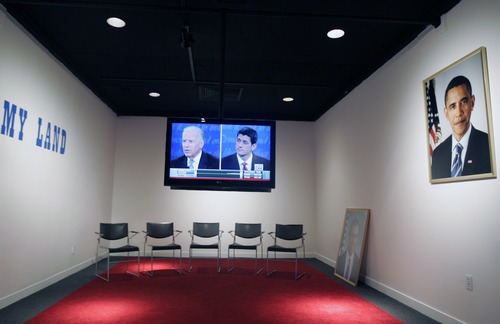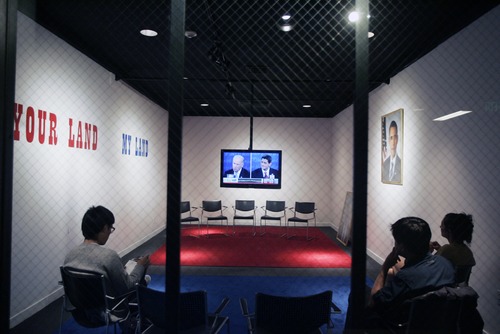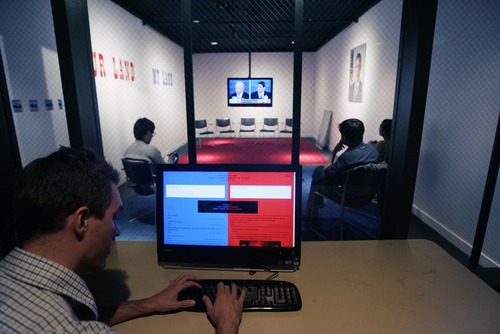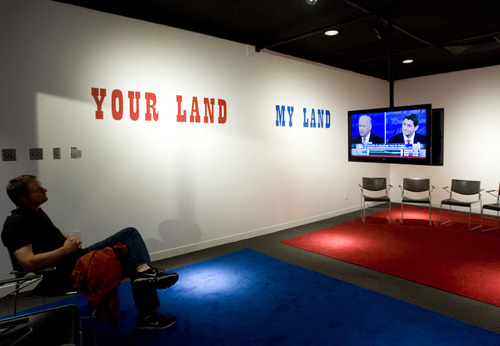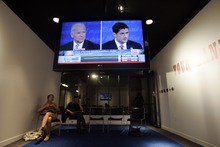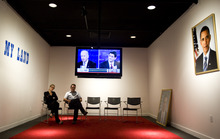This is an archived article that was published on sltrib.com in 2012, and information in the article may be outdated. It is provided only for personal research purposes and may not be reprinted.
Art is meant, to some people, to be permanent. Politics is usually focused on the day-by-day, or even hour-by-hour, changes in the news.
So what happens when art and politics meet?
"You hope to make something that speaks to now, and 50 years from now we still will find the conversation interesting," said Joe Norman, a Salt Lake City artist whose works include political art.
Norman is one of 16 artists who contributed works to "E Pluribus Unum," an exhibit on display at Utah State University in Logan.
The exhibit's curator, Orem-based artist Namon Bills, said the exhibition was inspired "by my own frustration that nothing can get done in our national government, that our two parties were busy fighting each other."
To make the point about the need for compromise, Bills had the 16 artists randomly pair up to collaborate.
"Artists are pretty particular about their ideas and their techniques, and about what a piece needs to be and what it needs to look like," Bills said. "It can be a challenge to meld those two visions together."
The solo work Bills contributed to the exhibit, "False Dichotomy," features a table — half red, half blue — with a chess set on it and an 8-foot cutout photo of the Statue of Liberty. He said the work speaks to the bipolar state of partisan politics, but stressed it is open to interpretation. "It allows the viewer to come around and take the meaning they get out of it."
—
Considering the red/blue divide • A similar red-vs.-blue idea is at play in an installation at Salt Lake City's Utah Museum of Contemporary Art. "Your Land/My Land: Election '12" is one of seven installations staged around the country by artist Jonathan Horowitz.
The minimalist installation is set in a room that's carpeted half in blue, half in red. Two big-screen TVs descend back to back from the ceiling, with the one on the red side tuned to Fox News and the one on the blue side set on MSNBC. On one wall are written words from Woody Guthrie's "This Land Is Your Land." On the opposite wall, a portrait of President Barack Obama hangs prominently, with a similar portrait of Mitt Romney on the floor nearby. On Election Night, if Romney wins, the portraits will be switched.
Horowitz, in a phone interview, said the installation "describes the political landscape of the present, where we have a very divided electorate and a very divided media that caters to the electorate."
The two sides must confront each other in the exhibit, unlike in everyday life. "People just tend to choose one side or the other, and you sort of get stuck in your comfort zone. You look for the information you want to hear," Horowitz said. "I think the way the installation works, you can sort of get caught up in it, and you might find yourself glued to one side or the other watching TV. But you can also step back, and go back and forth between the two sides."
The installation was open during this month's vice-presidential debate and will be open on Election Night for anyone wanting a cool place to watch the results and talk about them.
"I wanted it to be activated by people and be used in a very literal sense," Horowitz said. "I was hoping that the installation would engage more people in the political process and foster discussion."
—
Political art of the moment • Discussion is a key motivator to making political art, Norman agreed. "I enjoy trying to make political art that tries to foster some dialogue," he said. "You put up a poster that says 'I hate Obama' or 'I hate Romney,' that's very easy. There's no discussion. It doesn't tell you anything new."
For the "E Pluribus Unum" show, Norman created a work called "Others: Thoreau, Weiwei, DeChristopher, Solzhenitsyn." It features images of four men imprisoned for being, in Norman's view, political dissidents: the writer Henry David Thoreau, jailed as a tax resister; the Chinese artist Ai Weiwei, detained last year over a tax dispute; Utah environmental protester Tim DeChristopher, now finishing out a federal sentence for disrupting a Bureau of Land Management oil-lease auction; and Russian activist and author Aleksandr Solzhenitsyn, who exposed the Soviet labor-camp system.
Not all political art is meant to last, said Maria del Mar González, who teaches art history at the University of Utah.
"This whole idea of art being permanent is more of a recent thing," she said. "It's our obsession to keep these objects with us." González cites a familiar example: Shepard Fairey's iconic "Hope" poster, the red/blue portrait of then-candidate Obama. "It's very much a piece of its moment," she said.
During Franklin Roosevelt's New Deal, artists were hired to produce instructional posters. "These posters were not intended to last — they were intended to educate and inform," González said. "But because these were created by artists, we become obsessed with saving them and keeping them around."
Saving such works, González said, comes with some irony. "A lot of these [New Deal] pieces are in corporate collections," she said, "and a lot of these artists were socialists."
To Bills, the main point of political art is that it's as much art as it is political.
"For me, it's really important not to be too heavy-handed in trying to hit the viewer over the head and saying, 'This is what this means,' " Bills said. "At that point, it almost becomes a political cartoon. … I would like viewers to be able to say, 'I agree with that or disagree with that.' "
Provo painter makes the news, with help from right-wing stars
Utah painter Jon McNaughton may be the state's best-selling artist right now — thanks to mentions of his message-heavy works by conservative talkers such as Sean Hannity, Glenn Beck and Michelle Malkin.
The Provo-based painter (who, through a spokeswoman, declined a Salt Lake Tribune interview request) made a national splash with his 2010 painting "One Nation Under God," which depicts Jesus Christ holding the Constitution. Later works depicted President Barack Obama as an enemy to the Constitution, stepping on the document in "The Forgotten Man" and setting it ablaze in "One Nation Under Socialism."
McNaughton's politics aren't as simple as his paintings might suggest. In an interview with the website Salon in February, he espoused his belief in limited government — and noted that in the painting "The Forgotten Man," he has placed George W. Bush near Obama as an indication of McNaughton's disappointment with Bush. (The painter's website includes interactive guides, which explain the meaning behind every image within his paintings.)
His work has drawn scorn in some quarters. Jerry Saltz, the art critic for New York magazine (and one of the judges on the Bravo series "Work of Art"), told a CBS reporter in March that "One Nation Under Socialism" was "bad academic derivative realism" and "typical propaganda art, drop-dead obvious in message [and] visually dead as a doornail."
But nowhere has McNaughton's work been skewered more pointedly than by Stephen Colbert on Comedy Central's "The Colbert Report."
Colbert, in his TV persona of a right-wing blowhard host, in May fake-praised "The Forgotten Man" — which shows Obama with all the previous presidents behind him — by calling the art "so lifelike, you can almost hear the Founding Fathers standing behind him asking, 'Who gave that slave a suit?' " And Colbert said "One Nation Under God," in which McNaughton included an array of figures including George Washington and Ronald Reagan, was "like 'Where's Waldo?,' only what you're searching for is the slightest hint of subtlety."
Sean P. Means —
Where art meets politics
Some current exhibits in Utah that feature politically themed art:
"Your Land/My Land: Election '12"
Jonathan Horowitz's installation splits a room into half red, half blue, with back-to-back TV screens airing Fox News on one side and MSNBC on the other.
Where • Utah Museum of Contemporary Arts, 20 S. West Temple, Salt Lake City
When • Now through Nov. 24
Hours • Tuesday-Saturday, 11 a.m.-6 p.m. (open until 9 p.m. Fridays); special exhibit hours, 7 p.m. to late on election night, Nov. 6
Admission • Free
"Battleground States"
A collection of works by various artists that explore gender identity.
Where • Utah Museum of Contemporary Arts, 20 S. West Temple, Salt Lake City
When • Now through Jan 5
Hours • Tuesday-Saturday, 11 a.m.-6 p.m. (open 'til 9 p.m. Fridays); special exhibit hours, 7 p.m. to late on election night, Nov. 6
Admission • Free
"The Easiest Job in the World"
Political cartoons by The Salt Lake Tribune's Pat Bagley.
Where • Loge Gallery, Simmons Pioneer Memorial Theatre, 300 S. 1400 East, University of Utah campus, Salt Lake City
When • Through Nov. 3
Hours • Friday and Saturday, 10 a.m.-6 p.m., for the public; and for ticketholders for Pioneer Theatre's production of "Of Mice and Men," during preshow and intermission
Admission • Free during the day
"E Pluribus Unum"
Works on political themes by 16 Utah artists, both solo works and collaborations.
Where • Tippetts Exhibit Hall, Chase Fine Arts Center, Utah State University, Logan
When • Through Nov. 9
Hours • Monday-Friday, 10 a.m.-5 p.m.
Admission • Free


